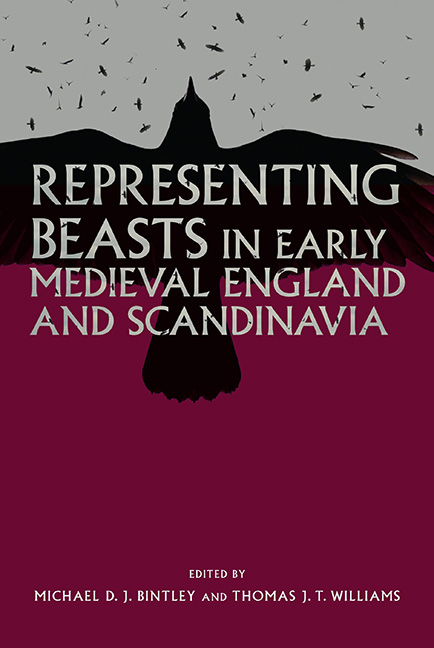Book contents
- Frontmatter
- Contents
- List of Figures and Tables
- Acknowledgements
- List of Contributors
- List of Abbreviations
- Introduction
- 1 Between Myth and Reality: Hunter and Prey in Early Anglo-Saxon Art
- 2 ‘(Swinger of) the Serpent of Wounds’: Swords and Snakes in the Viking Mind
- 3 Wreoþenhilt ond wyrmfah: Confronting Serpents in Beowulf and Beyond
- 4 The Ravens on the Lejre Throne: Avian Identifiers, Odin at Home, Farm Ravens
- 5 Beowulf’s Blithe-Hearted Raven
- 6 Do Anglo-Saxons Dream of Exotic Sheep?
- 7 You Sexy Beast: The Pig in a Villa in Vandalic North Africa, and Boar-Cults in Old Germanic Heathendom
- 8 ‘For the Sake of Bravado in the Wilderness’: Confronting the Bestial in Anglo-Saxon Warfare
- 9 Where the Wild Things Are in Old English Poetry
- 10 Entomological Etymologies: Creepy-Crawlies in English Place-Names
- 11 Beasts, Birds and Other Creatures in Pre-Conquest Charters and Place-Names in England
- Index
- Anglo-Saxon Studies
3 - Wreoþenhilt ond wyrmfah: Confronting Serpents in Beowulf and Beyond
Published online by Cambridge University Press: 11 June 2021
- Frontmatter
- Contents
- List of Figures and Tables
- Acknowledgements
- List of Contributors
- List of Abbreviations
- Introduction
- 1 Between Myth and Reality: Hunter and Prey in Early Anglo-Saxon Art
- 2 ‘(Swinger of) the Serpent of Wounds’: Swords and Snakes in the Viking Mind
- 3 Wreoþenhilt ond wyrmfah: Confronting Serpents in Beowulf and Beyond
- 4 The Ravens on the Lejre Throne: Avian Identifiers, Odin at Home, Farm Ravens
- 5 Beowulf’s Blithe-Hearted Raven
- 6 Do Anglo-Saxons Dream of Exotic Sheep?
- 7 You Sexy Beast: The Pig in a Villa in Vandalic North Africa, and Boar-Cults in Old Germanic Heathendom
- 8 ‘For the Sake of Bravado in the Wilderness’: Confronting the Bestial in Anglo-Saxon Warfare
- 9 Where the Wild Things Are in Old English Poetry
- 10 Entomological Etymologies: Creepy-Crawlies in English Place-Names
- 11 Beasts, Birds and Other Creatures in Pre-Conquest Charters and Place-Names in England
- Index
- Anglo-Saxon Studies
Summary
Serpents or dragons make several appearances in the Old English poem Beowulf. Famously, the narrative concludes with a dragonslaying, in which both the beast and the eponymous hero are mortally wounded. Earlier in the poem, after his first encounter with Grendel, a young Beowulf is approvingly compared to the dragon-slayer Sigemund. There is, in addition, a subtle evocation of dragons in the description of a hilt recovered from Grendel's mere after Beowulf's second encounter with the monstrous hall-scourge. This hilt, an ancient record of the world's first strife, is said to be both inscribed with runstafas (‘rune letters’, line 1695) and adorned with wyrmfah (‘serpent-patterned’, line 1698).
Runes and dragons have only been tangentially connected in medieval scholarship as lingering remnants of ancient Germanic mythology adapted for Christian audiences. This chapter argues that the reference to both dragons and runes in the description of Beowulf's ancient hilt is more than a momentary nod to the distant past. The same two elements, dragons and runes, are united in a number of other Anglo-Saxon and Old Norse sources, often in relation to treasure and worldly riches. Such instances, I would suggest, are not merely coincidental. Instead, we find dragons and runes, and the cultural concepts they represent, repeatedly set in opposition to one another, with the concealment associated with dragons being countered by the revealing nature of runic letters. An awareness of this opposition serves to emphasise the thematic and structural significance of the hilt in Beowulf. As Hrothgar gazes at the serpent-patterned heirloom he muses on the dangers of hoarded gold. In doing so he both speaks to social anxieties surrounding the appropriate distribution of wealth, and incidentally sets the stage for the poem's closing lines, in which Beowulf confronts his own treasure-hoarding dragon and the greed it represents.
The Serpent-Patterned Hilt
After successfully overcoming the Grendels in their own habitat, Beowulf returns to Hrothgar's hall in triumph. He arrives bearing both the head of the monster Grendel and the hilt of the sword that decapitated the monster's mother: tangible tokens of the hero's double victory and the Danes’ long-awaited salvation. Beowulf announces his entrance to Heorot with a triumphant Hwæt (line 1652), and presents Hrothgar with the plunder.
- Type
- Chapter
- Information
- Publisher: Boydell & BrewerPrint publication year: 2015
- 2
- Cited by



